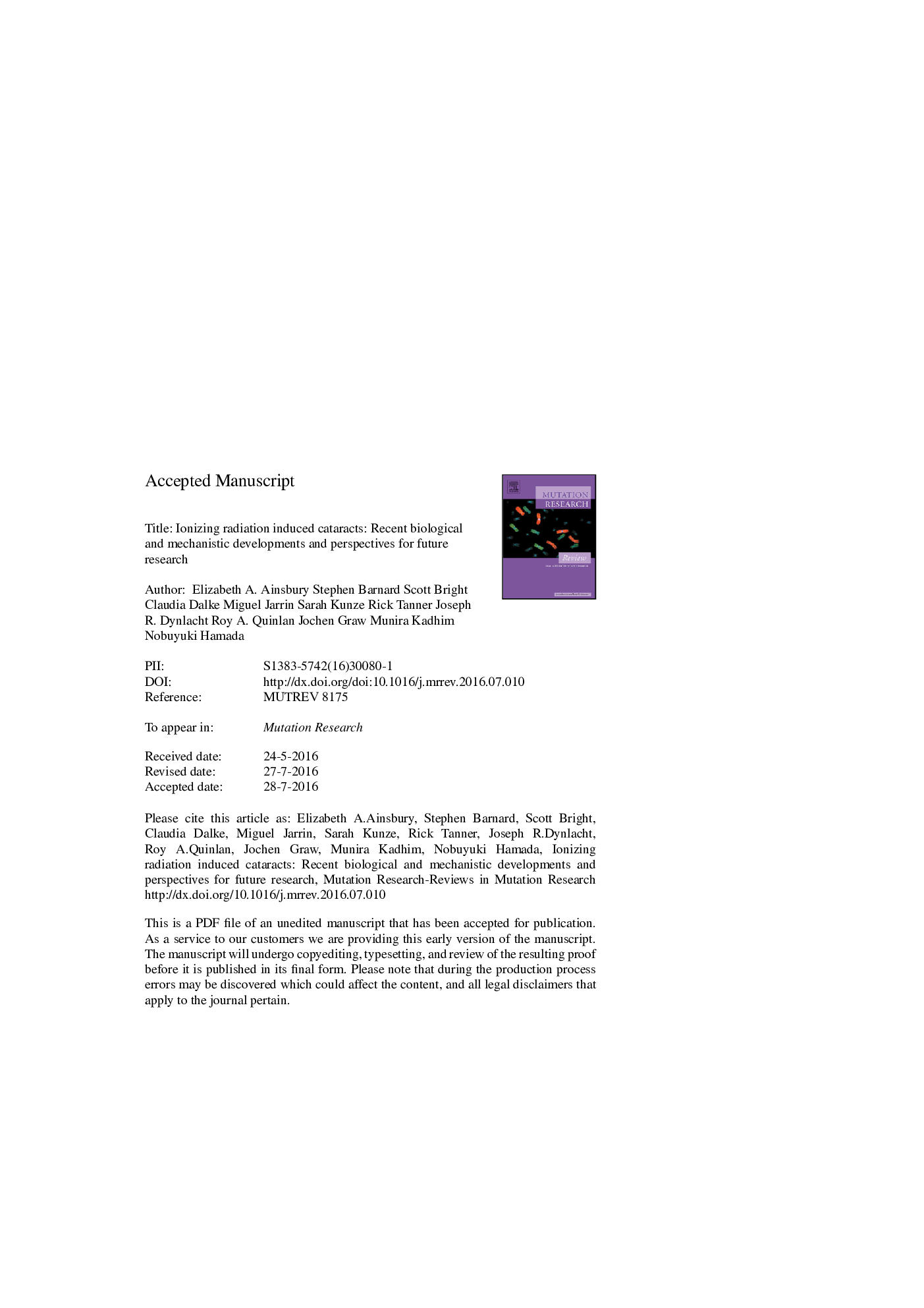| کد مقاله | کد نشریه | سال انتشار | مقاله انگلیسی | نسخه تمام متن |
|---|---|---|---|---|
| 5528910 | 1401667 | 2016 | 87 صفحه PDF | دانلود رایگان |
عنوان انگلیسی مقاله ISI
Ionizing radiation induced cataracts: Recent biological and mechanistic developments and perspectives for future research
ترجمه فارسی عنوان
پرتو یونیزاسیون آب مروارید: تحولات زیستی و مکانیکی اخیر و دیدگاه های پژوهشی آینده
دانلود مقاله + سفارش ترجمه
دانلود مقاله ISI انگلیسی
رایگان برای ایرانیان
کلمات کلیدی
ICRPIκBLFCFGF2IKKNBNNBSNDRG2ECMOFZLECγH2AXEphA2PTCH1SSBCDKN1ANTEOGG1N-myc downstream-regulated gene 2XPD53BP1P53-binding protein 1MCNPXRCC1PRDX6DNA single strand breakICRUinhibitor of nuclear factor κBMonte Carlo N-particleMedical Internal Radiation Dosexeroderma pigmentosum DRadiation cataractCOX-2BERLNTTGFβNF-κBPI3KMMPDSBTNFαRNSPSC8-oxoguanine DNA glycosylase 1 - 8-اکسوگوئین دی ان ای گلیکوزیلاز 1ataxia telangiectasia mutated - Ataxia telangiectasia جهش یافته استCa2+ - Ca2 +NER - DOWNROS - ROSAdenosine Triphosphate - آدنوزین تری فسفاتATP - آدنوزین تری فسفات یا ATPadenosine triphosphatase - آدنوزین تری فسفاتازEuropean Union - اتحادیه اروپاLET - اجازه دهیدRöntgen - اشعه ایکسUltraviolet - اشعه فرابنفشLinear Energy Transfer - انتقال انرژی خطیHES - او هستinterleukin - اینترلوکینATPase - ایتیپیایزها human embryonic stem - بذر جنین انسانCho - برایAtomic bomb - بمب اتمیionizing radiation - تابش یوننده یا پرتوهای یونیزانTransforming growth factor β - تبدیل فاکتور رشد βChinese Hamster Ovary - تخمدان هامستر چینیTropomyosin - تروپومیوسینnucleotide excision repair - تعمیر مجدد نوکلئوتیدیbase excision repair - تعمیر پایه پایهtumor necrosis factor α - تومور نکروز عامل αcomputed tomography - توموگرافی کامپیوتری یا سی تی اسکن یا مقطعنگاری رایانهایEMT - تکنسین فوریتهای پزشکیATM - خودپردازLens epithelial cell - سلول اپیتلیال لنزLens fiber cell - سلول فیبر لنزNijmegen breakage syndrome - سندرم شکستن نیهمگنcyclooxygenase 2 - سیکلوکوکسیژناز 2DNA double strand break - شکست دو رشته DNAMIRD - شیرینfibroblast growth factor 2 - عامل رشد فیبروبلاست 2gap junction - فاصله ی شکافnuclear factor κB - فاکتور هسته ای κBPhosphatidylinositol 3-kinase - فسفاتیدیلینواستیل 3-کینازExtracellular matrix - ماتریکس خارج سلولیmatrix metalloproteinase - ماتریکس متالوپروتئینازRIBE - ماهیTransitional zone - منطقه انتقالیcyclin-dependent kinase inhibitor 1A - مهار کننده 1A کیناز وابسته به کینازNibrin - نیترینRep - هرزهperoxiredoxin 6 - پریکسیردوکسین 6Single nucleotide polymorphism - پلیمورفیسم تک نوکلئوتیدیPatched 1 - پچ 1SNP - چندریختی تک-نوکلئوتیدposterior subcapsular cataract - کاتاراکت زیر کپسول خلفیInternational Commission on Radiological Protection - کمیسیون بین المللی حفاظت رادیولوژیکconnexin - کنسکسینEpithelial-mesenchymal transition - گذار اپیتلیال-مزانشیمیreactive nitrogen species - گونه های واکنش پذیر نیتروژنReactive oxygen species - گونههای فعال اکسیژنCalcium ions - یون کلسیم
موضوعات مرتبط
علوم زیستی و بیوفناوری
بیوشیمی، ژنتیک و زیست شناسی مولکولی
تحقیقات سرطان
چکیده انگلیسی
The lens of the eye has long been considered as a radiosensitive tissue, but recent research has suggested that the radiosensitivity is even greater than previously thought. The 2012 recommendation of the International Commission on Radiological Protection (ICRP) to substantially reduce the annual occupational equivalent dose limit for the ocular lens has now been adopted in the European Union and is under consideration around the rest of the world. However, ICRP clearly states that the recommendations are chiefly based on epidemiological evidence because there are a very small number of studies that provide explicit biological, mechanistic evidence at doses <2Â Gy. This paper aims to present a review of recently published information on the biological and mechanistic aspects of cataracts induced by exposure to ionizing radiation (IR). The data were compiled by assessing the pertinent literature in several distinct areas which contribute to the understanding of IR induced cataracts, information regarding lens biology and general processes of cataractogenesis. Results from cellular and tissue level studies and animal models, and relevant human studies, were examined. The main focus was the biological effects of low linear energy transfer IR, but dosimetry issues and a number of other confounding factors were also considered. The results of this review clearly highlight a number of gaps in current knowledge. Overall, while there have been a number of recent advances in understanding, it remains unknown exactly how IR exposure contributes to opacification. A fuller understanding of how exposure to relatively low doses of IR promotes induction and/or progression of IR-induced cataracts will have important implications for prevention and treatment of this disease, as well as for the field of radiation protection.
ناشر
Database: Elsevier - ScienceDirect (ساینس دایرکت)
Journal: Mutation Research/Reviews in Mutation Research - Volume 770, Part B, OctoberâDecember 2016, Pages 238-261
Journal: Mutation Research/Reviews in Mutation Research - Volume 770, Part B, OctoberâDecember 2016, Pages 238-261
نویسندگان
Elizabeth A. Ainsbury, Stephen Barnard, Scott Bright, Claudia Dalke, Miguel Jarrin, Sarah Kunze, Rick Tanner, Joseph R. Dynlacht, Roy A. Quinlan, Jochen Graw, Munira Kadhim, Nobuyuki Hamada,
